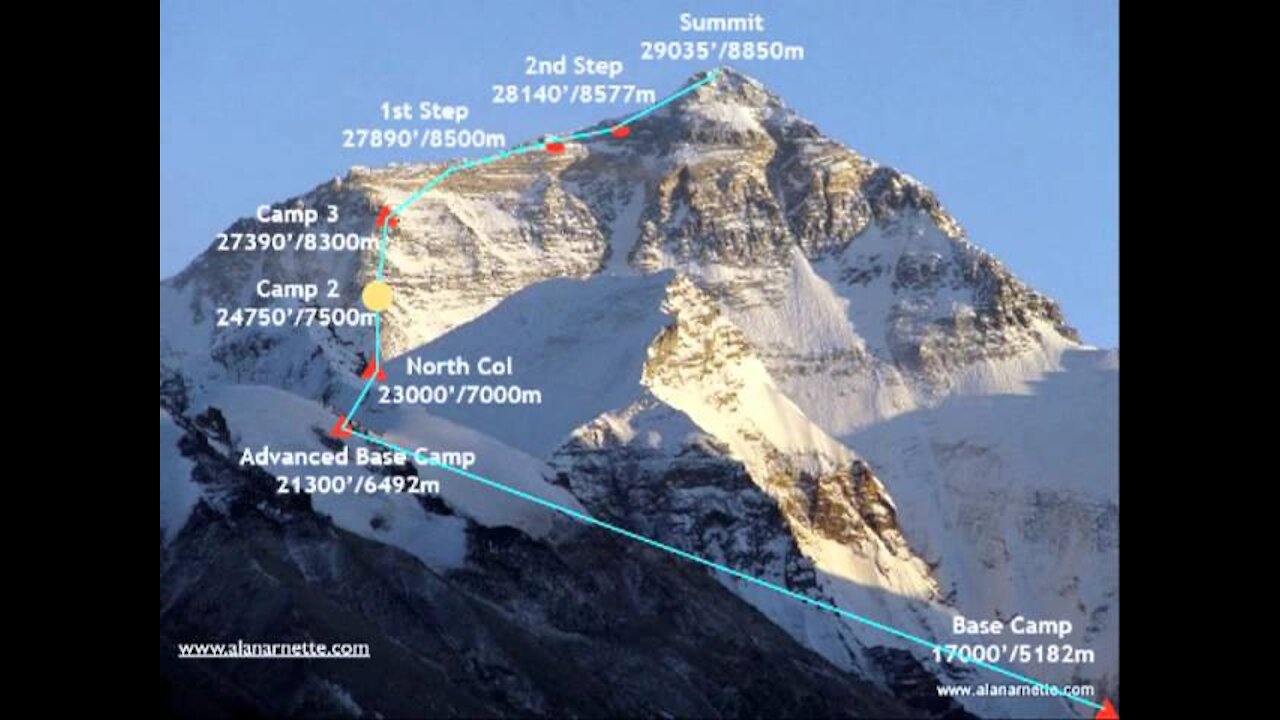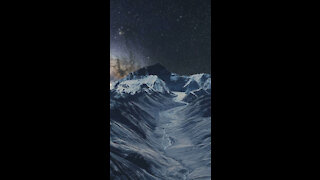Premium Only Content

Everest North Col Animated Route Map
Everest North Col Animated Route Map
This animation is based on Alan Arnette's personal experience of climbing on Everest 4 times and summiting on May 21, 2011. Not all teams will use this exact schedule to summit from the Tibet side via the North Col.
Mount Everest is Earth's most noteworthy mountain above ocean level, situated in the Mahalangur Himal sub-scope of the Himalayas. The China–Nepal line stumbles into its culmination point.Its rise (snow tallness) of 8,848.86 m (29,031.7 ft) was most as of late settled in 2020 by the Nepali and Chinese specialists.
Mount Everest draws in numerous climbers, some of them exceptionally experienced mountaineers. There are two fundamental climbing highways, one moving toward the culmination from the southeast in Nepal (known as the "standard course") and the other from the north in Tibet. While not presenting generous specialized climbing difficulties on the standard course, Everest presents risks like elevation affliction, climate, and wind, just as critical dangers from torrential slides and the Khumbu Icefall. Starting at 2019, more than 300 individuals have passed on Everest, large numbers of whose bodies stay on the mountain.
The originally recorded endeavors to arrive at Everest's highest point were made by English mountaineers. As Nepal didn't permit outsiders to enter the country at that point, the English made a few endeavors on the north edge course from the Tibetan side. After the principal observation campaign by the English in 1921 arrived at 7,000 m (22,970 ft) on the North Col, the 1922 undertaking pushed the north edge course up to 8,320 m (27,300 ft), denoting the first run through a human had move over 8,000 m (26,247 ft). Seven watchmen were slaughtered in a torrential slide on the plummet from the North Col. The 1924 endeavor brought about probably the best secret on Everest right up 'til today: George Mallory and Andrew Irvine made a last highest point endeavor on 8 June however stayed away forever, starting discussion with respect to whether they were quick to arrive at the top. They had been spotted high on the mountain that day yet vanished in the mists, gone forever, until Mallory's body was found in 1999 at 8,155 m (26,755 ft) on the north face. Tenzing Norgay and Edmund Hillary made the main authority climb of Everest in 1953, utilizing the southeast edge course. Norgay had arrived at 8,595 m (28,199 ft) the earlier year as an individual from the 1952 Swiss undertaking. The Chinese mountaineering crew of Wang Fuzhou, Gonpo, and Qu Yinhua made the previously announced rising of the top from the north edge on 25 May 1960.
The Nepali name for Everest is Sagarmāthā (सगरमाथा) which signifies "the Head in the Incomparable Blue Sky" got from सगर (sagar) signifying "sky" and माथा (māthā) signifying "head" in the Nepali Language.
Geologists have subdivided the rocks comprising Mount Everest into three units called formations. Each formation is separated from the other by low-angle faults, called detachments, along which they have been thrust southward over each other. From the summit of Mount Everest to its base these rock units are the Qomolangma Formation, the North Col Formation, and the Rongbuk Formation.
The Qomolangma Formation, also known as the Jolmo Lungama Formation, runs from the summit to the top of the Yellow Band, about 8,600 m (28,200 ft) above sea level. It consists of greyish to dark grey or white, parallel laminated and bedded, Ordovician limestone interlayered with subordinate beds of recrystallised dolomite with argillaceous laminae and siltstone. Gansser first reported finding microscopic fragments of crinoids in this limestone. Later petrographic analysis of samples of the limestone from near the summit revealed them to be composed of carbonate pellets and finely fragmented remains of trilobites, crinoids, and ostracods. Other samples were so badly sheared and recrystallised that their original constituents could not be determined. A thick, white-weathering thrombolite bed that is 60 m (200 ft) thick comprises the foot of the "Third Step", and base of the summit pyramid of Everest. This bed, which crops out starting about 70 m (230 ft) below the summit of Mount Everest, consists of sediments trapped, bound, and cemented by the biofilms of micro-organisms, especially cyanobacteria, in shallow marine waters. The Qomolangma Formation is broken up by several high-angle faults that terminate at the low angle normal fault, the Qomolangma Detachment. This detachment separates it from the underlying Yellow Band. The lower five metres of the Qomolangma Formation overlying this detachment are very highly deformed.
The bulk of Mount Everest, between 7,000 and 8,600 m (23,000 and 28,200 ft), consists of the North Col Formation, of which the Yellow Band forms its upper part between 8,200 to 8,600 m (26,900 to 28,200 ft). The Yellow Band consists of intercalated beds of Middle Cambrian diopside-epidote-bearing marble, which weathers a distinctive yellowish brown, and muscovite-biotite phyllite and semischist. Petrographic analysis of marble collected from about 8,300 m (27,200 ft) found it to consist as much as five percent of the ghosts of recrystallised crinoid ossicles. The upper five metres of the Yellow Band lying adjacent to the Qomolangma Detachment is badly deformed. A 5–40 cm (2.0–15.7 in) thick fault breccia separates it from the overlying Qomolangma Formation.[51][52][56]
The remainder of the North Col Formation, exposed between 7,000 to 8,200 m (23,000 to 26,900 ft) on Mount Everest, consists of interlayered and deformed schist, phyllite, and minor marble. Between 7,600 and 8,200 m (24,900 and 26,900 ft), the North Col Formation consists chiefly of biotite-quartz phyllite and chlorite-biotite phyllite intercalated with minor amounts of biotite-sericite-quartz schist. Between 7,000 and 7,600 m (23,000 and 24,900 ft), the lower part of the North Col Formation consists of biotite-quartz schist intercalated with epidote-quartz schist, biotite-calcite-quartz schist, and thin layers of quartzose marble. These metamorphic rocks appear to be the result of the metamorphism of Middle to Early Cambrian deep sea flysch composed of interbedded, mudstone, shale, clayey sandstone, calcareous sandstone, graywacke, and sandy limestone. The base of the North Col Formation is a regional low-angle normal fault called the "Lhotse detachment".
Below 7,000 m (23,000 ft), the Rongbuk Formation underlies the North Col Formation and forms the base of Mount Everest. It consists of sillimanite-K-feldspar grade schist and gneiss intruded by numerous sills and dikes of leucogranite ranging in thickness from 1 cm to 1,500 m (0.4 in to 4,900 ft). These leucogranites are part of a belt of Late Oligocene–Miocene intrusive rocks known as the Higher Himalayan leucogranite. They formed as the result of partial melting of Paleoproterozoic to Ordovician high-grade metasedimentary rocks of the Higher Himalayan Sequence about 20 to 24 million years ago during the subduction of the Indian Plate.[58]
Mount Everest consists of sedimentary and metamorphic rocks that have been faulted southward over continental crust composed of Archean granulites of the Indian Plate during the Cenozoic collision of India with Asia. Current interpretations argue that the Qomolangma and North Col formations consist of marine sediments that accumulated within the continental shelf of the northern passive continental margin of India before it collided with Asia. The Cenozoic collision of India with Asia subsequently deformed and metamorphosed these strata as it thrust them southward and upward. The Rongbuk Formation consists of a sequence of high-grade metamorphic and granitic rocks that were derived from the alteration of high-grade metasedimentary rocks. During the collision of India with Asia, these rocks were thrust downward and to the north as they were overridden by other strata; heated, metamorphosed, and partially melted at depths of over 15 to 20 kilometres (9.3 to 12.4 mi) below sea level; and then forced upward to surface by thrusting towards the south between two major detachments. The Himalayas are rising by about 5 mm per year.
In 2008, another climate station at around 8,000 m height (26,246 feet) went on the web. The station's first information in May 2008 were air temperature −17 °C (1 °F), relative mugginess 41.3 percent, barometrical pressing factor 382.1 hPa (38.21 kPa), wind bearing 262.8°, wind speed 12.8 m/s (28.6 mph, 46.1 km/h), worldwide sun oriented radiation 711.9 watts/m2, sun based UVA radiation 30.4 W/m2.[79] The task was arranged by Stations at High Height for Exploration on the Climate (Offer), which additionally positioned the Mount Everest webcam in 2011. The sunlight based controlled climate station is on the South Col.
One of the issues confronting climbers is the continuous presence of rapid winds. The pinnacle of Mount Everest reaches out into the upper lower atmosphere and enters the stratosphere, which can open it to the quick and freezing winds of the fly stream. In February 2004, a breeze speed of 280 km/h (175 mph) was recorded at the culmination and winds more than 160 km/h (100 mph) are common.These winds can pass climbers over Everest. Climbers ordinarily focus on a 7-to 10-day window in the spring and fall when the Asian rainstorm season is either firing up or finishing and the breezes are lighter. The pneumatic force at the highest point is around 33% what it is adrift level, and by Bernoulli's standard, the breezes can bring down the pressing factor further, causing an extra 14 percent decrease in oxygen to climbers. The decrease in oxygen accessibility comes from the diminished generally speaking pressing factor, not a decrease in the proportion of oxygen to other gases.
In the late spring, the Indian storm brings warm wet air from the Indian Sea to Everest's south side. Throughout the colder time of year, the west-southwest streaming plane stream moves south and blows on the pinnacle.
Everest
-
 0:36
0:36
MidwestConcepts
4 years agoThe Animated Vase
64 -
 0:20
0:20
EntertainmentVideos
4 years agoEverest Stars
39 -
 0:38
0:38
seeWDW
4 years agoExpedition Everest Clip 1
83 -
 6:26
6:26
ShaneRumbles
4 years agoNorth bound
18 -
 5:59
5:59
Personal Developers
4 years agoClick Funnels Animated Video
80 -
 0:08
0:08
OmnichannelMarketingstrategies
4 years agoOmniChannel Animated Graphic Intro
57 -
 19:01
19:01
Russell Brand
9 hours agoTheo Von Just SHOCKED EVERYBODY With His Take on Trump Tariffs
65.9K91 -
 14:22
14:22
Tundra Tactical
3 hours ago $2.36 earnedTRUMP DOJ Decides CZ Scorpion Is A Decepticon.
26.8K14 -
 LIVE
LIVE
Culturama Podcast
2 hours ago $0.02 earnedEaster Special! Hollow Knight Stream!
155 watching -
 1:04:29
1:04:29
Sarah Westall
5 hours agoThe Philippines and Massive Stores of Gold for all the People of the World w/ Joseph Allain
31.6K27